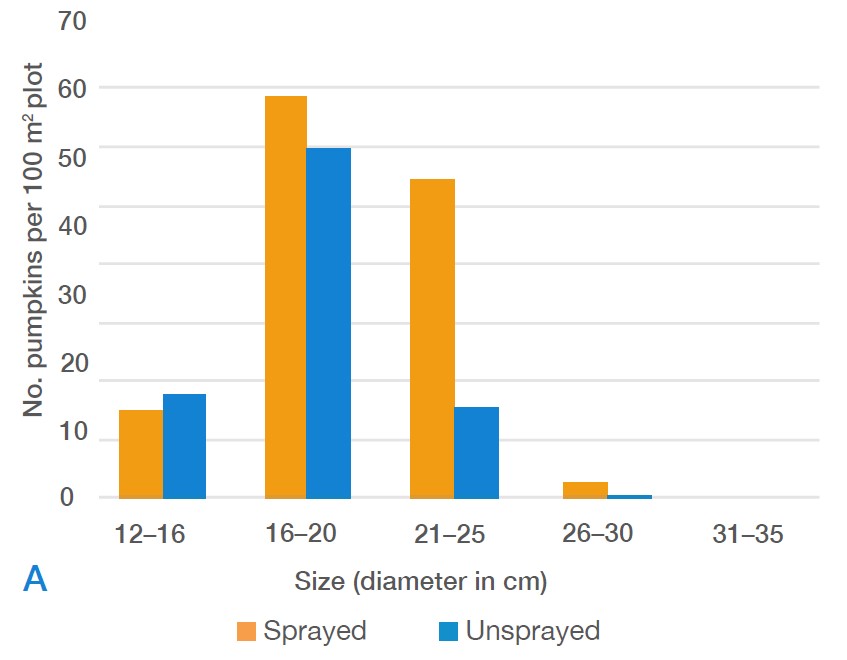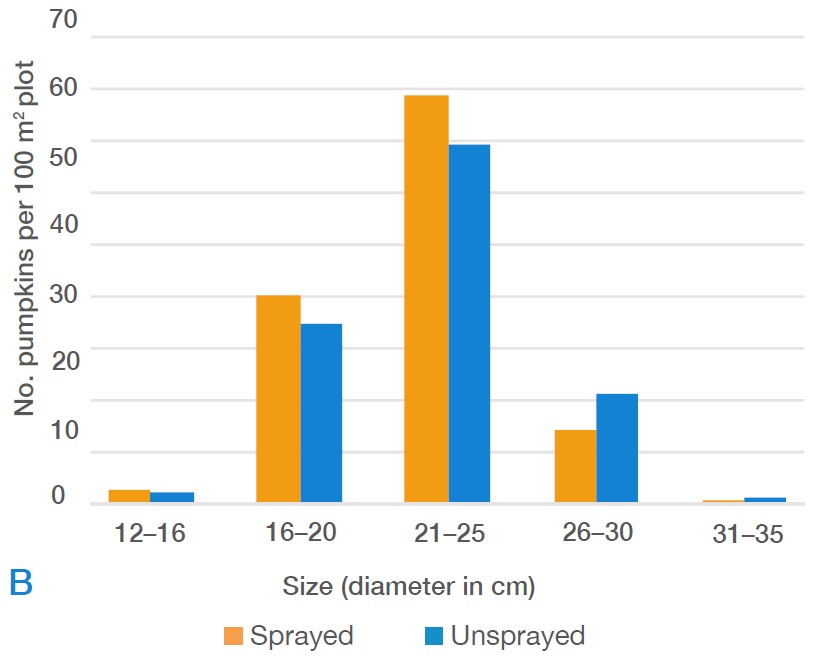Please click here to access the main AHDB website and other sectors.
- Home
- Knowledge library
- How to reduce pumpkin storage losses
How to reduce pumpkin storage losses
The use of fungicides and nutrition on pumpkin crops showed a reduction in losses at both the Cambridgeshire and Kent sites used in our trial. Find out more below.
Back to: Improving pumpkin storage
Treating Phoma cucurbitacearum and powdery mildew in pumpkins
In 2016, we tested spray treatments at two UK sites to see if they would protect pumpkin crops from both Phoma cucurbitacearum and powdery mildew. We also added mineral nutrition to growing crops.
Fungal sprays
For fungal control, we used Signum (Boscalid/pyraclostrobin) and Nimrod (Bupirimate). Signum is known to be effective against powdery mildew, as well as Cladosporium species – we also expected it to work against Phoma. Nimrod is known to protect crops from powdery mildew.
Mineral nutrition
We treated crops at both sites with mineral nutrition focused on calcium, boron, manganese, copper and magnesium sulphate.
See Table 1 for the field treatments we trialled.
Table 1. Applications of fungicide and nutrition used in field trial in Cambridgeshire and Kent in 2016
|
Site |
Date |
Fungicide |
Nutrition |
|
Cambridgeshire |
27/07/2016 |
Signum (1.5 L/ha) |
Calcium 1 L/ha, boron 1 L/ha |
|
08/08/2016 |
Nimrod (600 ml/ha) |
Calcium 1 L/ha, copper oxychloride 2 L/ha, manganese (as per label) |
|
|
18/08/2016 |
Signum (1.5 L/ha) |
Calcium 1 L/ha, manganese (as per label) |
|
|
Kent |
18/07/2016 |
Signum (1.5 L/ha) |
Calcium 1 L/ha, boron 1 L/ha |
|
05/08/2016 |
Nimrod (600 ml/ha) |
Calcium 1 L/ha, full trace elements foliar feed |
|
|
20/08/2016 |
Pot Bicarb (5 L/ha) + silica wetting |
Calcium 1 L/ha, manganese (as per label), Bittersalz (magnesium sulphate ) as per label |
The results
The number and size of pumpkins increased at both sites – see the Cambridgeshire and Kent sites, see Graphs A and B for details.
Harvested pumpkins were stored in bins under cover for 12 weeks (longer than is usual). When they were checked, the incidence of rot was much reduced from previous crops, suggesting that the fungicides and nutrition added while they were growing had effectively reduced storage losses.
The trial showed it was worth the extra spraying costs of £0.80 per pumpkin:
- A spend of £232 per hectare in Kent gave a gain of £560
- A spend of £341 per hectare in Cambridgeshire gave a much larger gain of £3,760


Conducting your own trials
The results of our trials are based on just two grower sites in a single season. More information from grower tests about the effects of different types of fungal control and nutrition strategies will help everyone learn more about reducing pumpkin losses and increasing profits.
If you’d like to get more insight on your own experiments, try to coordinate with another grower to run the same trial on each of your sites over the same time period and review results together.
Consider different strategies on a range of pumpkin varieties in different locations and types of soil. You can use unsprayed plots to compare the results.
Note: you should only use plant protection products that have been approved for use on pumpkins.
Useful links
See: What causes storage losses in pumpkins?
Download the PDF: Crop management strategies to improve pumpkin storage
Read our outdoor cucurbit crop walkers’ guide
If you would like to order a hard copy of the Outdoor cucurbit crop walkers' guide please contact:
Email: publications@ahdb.org.uk
Telephone: 0247 799 0069
This information was written by Debbie Rees, Richard Colgan, Marcin Glowacz – NRI, University of Greenwich Peter Waldock – Growing Earth Consultancy Ltd. Gerard Bishop, Robert Saville, Jennifer Kingsnorth – NIAB EMR.
Topics:
Sectors:
Tags:

